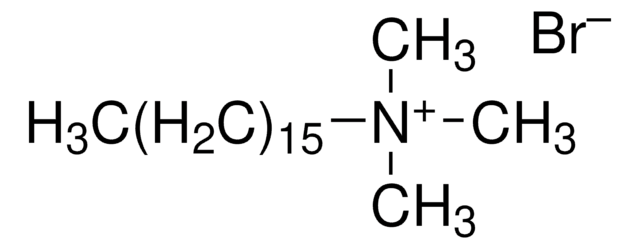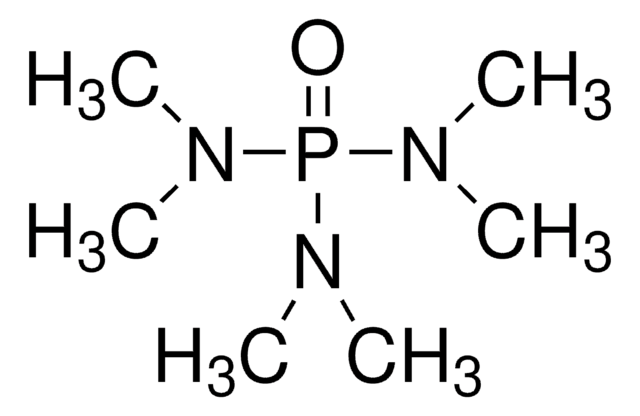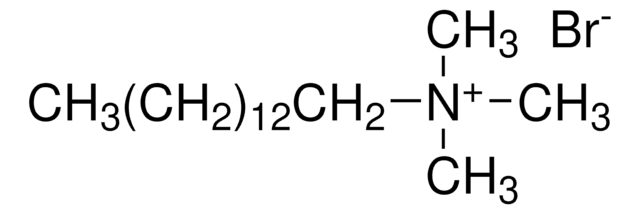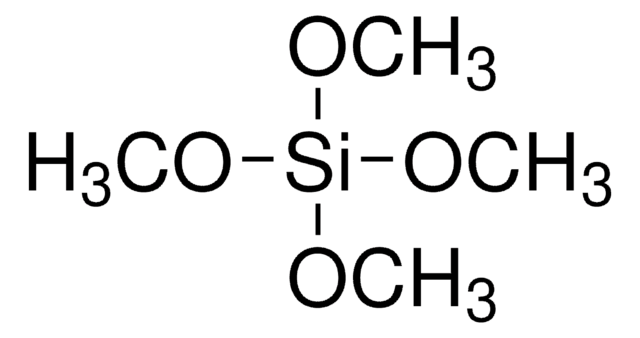52370
Bromuro de hexadeciltrimetilamonio
≥96.0% (AT)
Sinónimos:
Bromuro de cetiltrimetilamonio, Bromuro de cetrimonio, Bromuro de palmitiltrimetilamonio, CTAB
About This Item
Productos recomendados
description
cationic
Quality Level
assay
≥96.0% (AT)
form
powder or chunks
mol wt
364.45 g/mol
technique(s)
UV/Vis spectroscopy: suitable
electrophoresis: suitable
mp
248-251 °C (lit.)
solubility
H2O: 1 g/10 mL (warm)
application(s)
detection
SMILES string
[Br-].CCCCCCCCCCCCCCCC[N+](C)(C)C
InChI
1S/C19H42N.BrH/c1-5-6-7-8-9-10-11-12-13-14-15-16-17-18-19-20(2,3)4;/h5-19H2,1-4H3;1H/q+1;/p-1
InChI key
LZZYPRNAOMGNLH-UHFFFAOYSA-M
¿Está buscando productos similares? Visita Guía de comparación de productos
Categorías relacionadas
General description
Application
<li><strong>Sensitive detection in spectroscopy:</strong> The surface-active properties of Hexadecyltrimethylammonium bromide enhance the FRET effect in Cu-doped NH2-MIL-88(Fe), used for the highly sensitive detection of 3-nitro-L-tyrosine in biomolecular spectroscopy, contributing to advancements in diagnostic techniques and chemical analysis (Xu et al., 2024).</li>
<li><strong>Stabilization of heavy metals:</strong> Utilized in the intercalation-exfoliation modification of vermiculite for the stabilization of heavy metals during the pyrolysis of solid waste and sludge, Hexadecyltrimethylammonium bromide shows potential in waste management and pollution control, contributing to safer environmental practices (Yang et al., 2024).</li>
</ul>
signalword
Danger
Hazard Classifications
Acute Tox. 4 Oral - Aquatic Acute 1 - Aquatic Chronic 1 - Eye Dam. 1 - Skin Irrit. 2 - STOT RE 2 Oral - STOT SE 3
target_organs
Gastrointestinal tract, Respiratory system
Storage Class
11 - Combustible Solids
wgk_germany
WGK 3
flash_point_f
471.2 °F - closed cup
flash_point_c
244 °C - closed cup
ppe
dust mask type N95 (US), Eyeshields, Faceshields, Gloves
Choose from one of the most recent versions:
¿Ya tiene este producto?
Encuentre la documentación para los productos que ha comprado recientemente en la Biblioteca de documentos.
Los clientes también vieron
Nuestro equipo de científicos tiene experiencia en todas las áreas de investigación: Ciencias de la vida, Ciencia de los materiales, Síntesis química, Cromatografía, Analítica y muchas otras.
Póngase en contacto con el Servicio técnico






